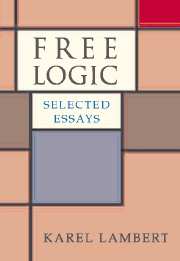Book contents
- Frontmatter
- Contents
- Introduction
- 1 Russell's Version of the Theory of Definite Descriptions
- 2 Existential Import, ‘E!’ and ‘The’
- 3 The Reduction of Two Paradoxes and the Significance Thereof
- 4 The Hilbert-Bernays Theory of Definite Descriptions
- 5 Foundations of the Hierarchy of Positive Free Definite Description Theories
- 6 Predication and Extensionality
- 7 Nonextensionality
- 8 The Philosophical Foundations of Free Logic
- 9 Logical Truth and Microphysics
Introduction
Published online by Cambridge University Press: 05 June 2012
- Frontmatter
- Contents
- Introduction
- 1 Russell's Version of the Theory of Definite Descriptions
- 2 Existential Import, ‘E!’ and ‘The’
- 3 The Reduction of Two Paradoxes and the Significance Thereof
- 4 The Hilbert-Bernays Theory of Definite Descriptions
- 5 Foundations of the Hierarchy of Positive Free Definite Description Theories
- 6 Predication and Extensionality
- 7 Nonextensionality
- 8 The Philosophical Foundations of Free Logic
- 9 Logical Truth and Microphysics
Summary
In one way or another the nine chapters of this book all have to do with free logic. Most are updated revisions in and adaptations of previously published papers. The exceptions are Chapters 4 and 5, though Chapter 4 contains a revised segment from a recently published paper.
Chapter 1 began as an invited address to the Western Division of the American Philosophical Association Meetings in 1991, and at the request of the organizers of those meetings was subsequently published in slightly revised form in Philosophical Studies, 65 (1992), pp. 153–167. It is a critical analysis of Russell's famous theory of definite descriptions of which there are two quite distinct versions. The defining feature of either version is that definite descriptions are not singular terms. That the essence of Russell's theory has to do with logical grammar was stressed in my ‘Explaining away singular existence statements’, Dialogue, 1 (1963), pp. 381–389, and later, independently, by David Kaplan in ‘What is Russell's theory of descriptions?’ Physics, History and Logic (eds. W. Yourgrau and A. Breck), Plenum Press, New York (1970), pp. 277–288.
- Type
- Chapter
- Information
- Free LogicSelected Essays, pp. ix - xiiPublisher: Cambridge University PressPrint publication year: 2002

